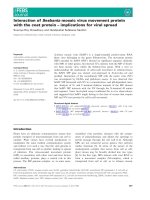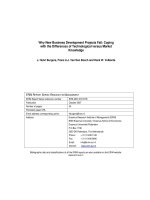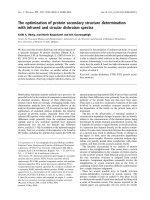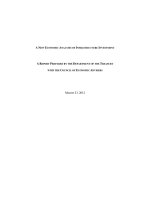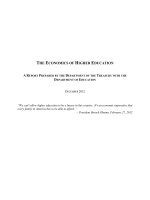Ant functional group succession dynamics correlates with the age of vegetation succession data analysis of worldwide studies and a case study of a secondary tropical rain forest in singapore
Bạn đang xem bản rút gọn của tài liệu. Xem và tải ngay bản đầy đủ của tài liệu tại đây (868.84 KB, 109 trang )
ANT FUNCTIONAL GROUP SUCCESSION
DYNAMICS CORRELATES WITH THE AGE OF
VEGETATION SUCCESSION: DATA ANALYSIS
OF WORLDWIDE STUDIES AND A CASE STUDY
OF A SECONDARY TROPICAL RAIN FOREST IN
SINGAPORE
THAM KOON HUNG, ANDREW
(B.Sc. (Hons.), NUS)
A THESIS SUBMITTED FOR THE DEGREE OF MASTER OF
SCIENCE
DEPARTMENT OF BIOLOGICAL SCIENCES
NATIONAL UNIVERSITY OF SINGAPORE
2006
a
0
ACKNOWLEDGEMENTS
My deepest gratitude to Associate Professor Li Daiqin, who not only guided me and
kept me focused on this project but also allowed me the freedom to think and play with
ideas. I will look back many years from now and wonder where I would have gone
without him. My heartfelt thanks to members of the Spider Lab, whose friendship kept
me young-at-heart, especially Jeremy Woon for all the “lunge” sessions, Matthew Lim
for the “tech support”, Olivia Tan for evaluating the standards of my jokes, Seah Wee
Khee for actually laughing at them, Chris Koh for the entertaining CDs. I thank Reuben
Clements and Kelvin Peh for their patience and enormous help with data analysis,
Darren Yeo for his initial advice on being an ant taxonomist, the National Parks Board,
Chew Ping Ting and Benjamin Lee for approving the research permit, supplying the
GIS data and guidance when I was lost in the jungle. To Faith, my precious daughter,
for giving me the impetus to finish this thesis. To my ever-lovely, then-girlfriend and
now wife, Geraldine, without whom I may never have had the belief in myself to do
anything meaningful in life. Finally, to JC, my constant but silent friend: thanks for
forgiving my nonsense.
“Go to the ant, thou sluggard; consider her ways, and be wise...”
- The Bible
i
TABLE OF CONTENTS
Page
ACKNOWLEDGEMENTS
i
TABLE OF CONTENTS
ii
ABSTRACT
iii
LIST OF TABLES
iv
LIST OF FIGURES
v
CHAPTER 1
GENERAL INTRODUCTION
1
CHAPTER 2
ANALYZING PUBLISHED DATA TO STUDY THE
10
SUCCESSION ECOLOGY OF ANTS
CHAPTER 3
Introduction
10
Material and Methods
15
Results
20
Discussion
33
ANT SUCCESSION DYNAMICS IN A SECONDARY
41
RAIN FOREST OF SINGAPORE
CHAPTER 4
Introduction
41
Material and Methods
46
Results
55
Discussion
66
GENERAL DISCUSSION
72
REFERENCES
81
APPENDIX
95
ii
ABSTRACT
Many studies have shown that ant communities respond to changes in the environment
but some questions remain unanswered. What functional groups dominate different
types of ecosystems? What groups succeed one another? Are there trends in the
succession of ant communities in relation to vegetation succession? To answer these
questions, data analysis of existing studies from six terrestrial ecosystems, viz. tropical
rain forest, montane forest, temperate forest, desert, subtropical grassland, tropical
bushland, was performed. I showed that each habitat had different dominant functional
group. In tropical rain forests, Opportunist and Tropical Climate Specialist functional
groups were the pioneer community that established in young, disturbed vegetation.
These two groups were succeeded by Cryptic Species, Generalized Myrmicinae and
Specialized Predator groups during vegetation succession. Sigmoidal mathematical
models best described the decline and growth of these two communities, respectively. I
demonstrated this pattern of functional group succession by conducting a study of the
ant community within a secondary tropical rain forest in Singapore. Using the
mathematical models, the ages of different locations in this forest were estimated. This
pattern of functional group succession implies that ants may be used as bioindicators
during forest rehabilitation. Directed studies on specific groups may be conducted to
assess their impact on forests at different stages of succession. The mathematical
models represented a first step in developing tools for estimating forest age where
historical records are lacking.
iii
LIST OF TABLES
Page
Table 1. Summary table of studies on ants.
19
Table 2. Description of the typical vegetation found in each of the four Forest
52
Types in Singapore.
Table 3. Study site, forest type and environmental variables.
54
Table 4. Variance in species data (r2) represented by the three axes of
62
ordination and the coefficients of correlation of significant
environmental variables with axes two and three.
Table 5. MRPP Results of average within-group (Forest Type) distances and
63
pair-wise comparisons between groups.
iv
LIST OF FIGURES
Page
Figure 1.
Proportions of functional groups in tropical rain forest,
24
temperate forest and desert.
Figure 2.
Proportions of functional groups in subtropical bushland,
25
montane forest and tropical grassland.
Figure 3.
Relationships between proportions of functional groups and age
26
of forests.
Figure 4.
Relationships between proportions of functional groups and age
27
of forests.
Figure 5.
Correlations of proportions of Opportunist with Generalized
28
Myrmicinae, Cryptic Species and Specialized Predator ants.
Figure 6.
Correlations of Cryptic Species with Tropical Climate Specialist,
29
Generalized Myrmicinae and Specialized Predator ants.
Figure 7.
Correlations between proportions of functional groups with one
30
another.
Figure 8.
Correlation between proportions of Tropical Climate Specialist
31
and Specialized Predator ants.
Figure 9.
Relationship between proportions of Cold Climate Specialist and
31
age of temperate forests.
Figure 10.
Sigmoid curves relating the proportions of functional groups and
32
the age of tropical rain forests.
Figure 11.
Sketch map of Singapore main island.
45
v
Figure 12.
Study sites and transects in the Central Catchment Nature
53
Reserve.
Figure 13.
Correlation between proportions of functional groups and the
58
ranked age of Forest Type.
Figure 14.
Correlation between proportions of functional groups and the
59
ranked age of Forest Type.
Figure 15.
Correlations of proportions of Cryptic Species, Generalized
60
Myrmicinae and Specialized Predator groups with Opportunist
group.
Figure 16.
Correlations of proportions of Cryptic Species, Generalized
61
Myrmicinae and Specialized Predator groups with Tropical
Climate Specialist group
Figure 17.
NMS plots of species and site scores.
64
Figure 18.
Estimated mean age of different Forest Types.
65
vi
CHAPTER 1
GENERAL INTRODUCTION
Succession Ecology
Ecosystems are not static entities. Conditions within habitats vary widely and one group
of these variations is ecological succession cycles. For example, large trees in primary
rain forests often collapse, leaving gaps in the canopy and creating patches where
secondary succession takes place (Whitmore, 1998). The gaps slowly return to the
primary condition after many years, completing the cycle (Whitmore, 1998). There are
similar cycles in other areas such as aquatic habitats (Wetzel, 1995).
The general trend seen in ecological succession is that of particular community
structure and environmental conditions replacing another over time. There usually is a
set of environmental conditions that allow a certain community to thrive. As this
community ages, the conditions change and another set of community more suited to
the new conditions gradually take over (McCook, 1994). Furthermore, it is not just the
interactions between environment and community that play important roles. Interactions
between different species are also important in determining the path of succession
(Farrell, 1991).
In addition, one of the most important determinants of whether an ecosystem
recovers naturally is the disturbance caused by humans. The over-riding significance of
the ecological footprints created by anthropogenic disturbance is clearly demonstrated
1
in large-scale landscape changes brought about through the advancement and
development of human civilization (DeFries et al, 2005). The natural cycles are either
altered or replaced by artificial cycles. For example, cultivated landscapes that were
subsequently abandoned often do not have the conditions that are necessary for growth
into its original uncultivated state (Roth, 1999).
The natural resources of this planet are limited but yet are being exploited at a
high rate (DeFries et al, 2005). There is an urgent need to restore exploited ecosystems
and bring it back from the brink of collapse. This is important because ecosystems
provide numerous services (Bennett et al, 2005). Having a good understanding of
succession ecology will enable stakeholders of the environment to effectively
rehabilitate and conserve natural resources so that sustainable use is achieved for the
long term (Leitao and Ahern, 2002).
Many ecologists try to grasp the complexity of succession by describing its
individual components and making useful extrapolations in order to understand general
trends (Underwood, 1997). Another challenge that ecologists deal with is to come up
with reliable models of prediction from their observations. Predictive models in ecology
are useful in that it allows researchers to work on a general level with fewer variables to
estimate the responses of ecosystems (Brook et al, 2000). Such models could serve as
an alert mechanism for possible impending ecological crisis, much like climate change
and global warming models (Viner et al, 1995).
One of the components of succession is the animal community. The fauna of a
habitat changes with the succession cycle (Done, 1992). Therefore, ecologists often
study changes in populations and communities of animals that affect and are themselves
affected by succession. For example, the community structure, species richness and
2
abundance are different at different stages of succession (Done, 1992). Ants are
considered a useful group of organisms for the study of ecosystem succession. This is
because of their relatively wide ecological range (Holldobler and Wilson, 1990) and the
different responses of different species to changes in the habitats (Andersen, 1995).
Aspects of ant biology and their significance in ecosystems will be discussed shortly.
Biology of The Ants
“Ants are everywhere,” Holldobler and Wilson (1990) once commented. It is not
surprising that such a statement was made. Ants are insects, which constitute over 75%
of all estimated animal species on this planet (Ruppert and Barnes, 1994). There are
more than 9,000 described species of ants in nearly 300 genera, forming the entire
family Formicidae, within the order Hymenoptera (Bolton, 1994).
There are three anatomical features found in the ant that set it apart from other
insects. First, ants have narrow proximal segments of the abdomen joining the thorax.
These narrow segments are known collectively as the petiole (Bolton, 1994). Second,
the mandibles of an ant are elongated and highly modified for grasping and cutting
(Holldobler and Wilson, 1990). The ants use their mandibles for a variety of purposes,
including manipulation of objects, defense and communication (Holldobler and Wilson,
1990). Third, ants have a pair of metapleural gland on the last segment of the thorax
(Holldobler and Wilson, 1990). These glands produce phenylacetic acid, which has
antibiotic properties (Beattie et al, 1986). The metapleural gland is present only in ants
and has been described as their defining characteristic (Holldobler and Wilson, 1990).
3
An interesting aspect of the ants is the social nature of their existence. Ants are
eusocial insects, meaning they live and interact closely in a colony and only one or a
minute portion of individuals in the entire colony reproduces while the rest are sterile
(Gadagkar, 1994). The study of this social nature of the ants’ existence has yielded great
insights into the areas of animal communication and behavior. We now know that there
are many classes of chemicals used in communication within and across species (Law
and Regnier, 1971; Nordlund, 1981). The nature, quantity and stereochemistry of such
chemicals differentiate the types of signals sent (Holldobler, 1983a). In addition to
chemical signals, the ants use complex sequences of tactile signals and body movements
to convey information regarding food source, recruitment needs and defense, among
others (Holldobler and Wilson, 1978), much like the well-known waggle dance of
honeybees (Judd, 1995).
The study of ant society has helped introduced the concept of altruism to the
field of evolutionary biology (Wilson, 1975). Altruism may be defined as actions
undertaken by an individual that benefit others at a detrimental cost to that individual
performing these actions (Le Galliard et al, 2005). Altruistic actions by the ants include
the worker caste foregoing its reproductive functions while tending to the welfare of the
reproductive caste and older workers stationing themselves at the territorial boundaries
of the colony where mortality rates are higher due to increased predation (Porter and
Jorgensen, 1981) and confrontation with other ant colonies (Holldobler, 1983b). The
study of altruism has contributed many ideas to the fields of kin selection and
sociobiology (Wilson, 1971; 1975). Wilson (1975) had even argued a Darwinian
explanation for the existence and perpetuation of human culture based on altruism and
kin selection.
4
Ants belong to different levels of the food pyramid. Seed harvester ant species
of the genus Pogonomyrmex are primary consumers (Pol and Casenave, 2004) while
certain species of Iridomyrmex are secondary or higher consumers that hunt and feed on
other arthropods (Gibb and Hochuli, 2004). Still other species are parasites or
detritivores. Ants are also important prey. For example, disturbances in ant populations
have been known to affect the animals feeding on them (Suarez and Case, 2002).
Ants form symbiotic relationships with other insects. This include ants tending
the larva of Riodinidae butterflies, protecting the latter from predators while feeding on
the sugary secretion that these larva produce (Ross, 1966). Some butterfly species even
spend their pupal stage within the nests of the ants (Holldobler and Wilson, 1990). In
addition to animals, symbiotic relationships with plants are also common. For example,
species of Crematogaster, which live within the Macaranga plant, reduce the damage
from herbivory suffered by these plants (Murase et al, 2003). Holldobler and Wilson
(1990) gave a fascinating account of how a number of fungal species are obligately and
asexually propagated by fungi-culturing ants. These fungi are not known to reproduce
naturally without the help of the ants (Weber, 1957).
Human beings have both been affected by and taken advantage of ants. The fire
ant, Solenopsis invicta, destroys human properties through its disruptive nesting activity
(Greenberg et al, 2003) and causes deadly anaphylactic reactions in people who are
allergic to the venom found in the ants’ stings (Solley and Vanderwoude, 2004). There
have been many instances of humans using ants as a form of pest management and
records of ancient Chinese history showed that the leaf-weaver ant, Oecophylla
smaragdina, was cultivated on fruit trees to deter or reduce pest damage and this
method is still employed in parts of China as an alternative to chemical pesticides
5
(Huang and Yang, 1987). Way and Khoo (1992) has an excellent review on the subject
of ants as bio-control agents.
The Ecology of Ants
The composition of ant species in different ecosystems, like temperate forests (Maeto
and Sato, 2004), deserts (Nash et al, 2004), montane forests (Robertson, 2002) and
lowland rain forests of the tropics (Yamane et al, 1996), differ from one another. It is
also known that species composition within the same habitat is influenced by different
environmental conditions (Vasconcelos, 1999) and competitive interactions (Andersen,
1995).
There has been much progress in the study of the distribution of ant
communities in different habitats ever since Andersen (1995) proposed a functional
group classification of Australian ants. Under this classification system, ants in
Australia were grouped based on their hypothesized community dynamics, niche
requirements and evolutionary history (Andersen, 1995). Using this classification, King
et al (1998) was able to show that the proportions of different functional groups
sampled in primary, young and old secondary lowland tropical rain forests were
different. Environmental conditions and community dynamics change as vegetation
succession takes place (Whitmore, 1998) and it is, therefore, possible that functional
groups of ants replace one another during the process. In other words, the proportions of
functional groups that may be sampled could be different in secondary forests of
different ages.
6
Another notable progress was made when Brown (2000) widened the concept of
functional groups to cover most genera of ants around the world. The genera and
matching functional groups are listed in Appendix A. It is now possible to study the
distribution patterns of ants around the world in terms of functional groups. The use of
the functional group concept for the purpose of studying ant ecology has two potential
advantages over traditional species-based studies. First, traditional ant taxonomy is
based largely on external morphology, fossil records (Bolton, 1994) and, increasingly in
recent years, phylogenetics (Ohnishi et al, 2003) while it ignores the resource
requirement of each species. Therefore the responses of functional groups to changes in
the habitat could, in theory, be much easier to predict over that of a community of
species (Andersen, 1995). Second, in trying to grapple with the numerous species while
looking for meaningful patterns, many ecologists try to reduce as much data as possible
while retaining useful information (McCune and Grace, 2002). Most described ants
found in ecological samples may be classified into one of nine functional groups
(Brown, 2000). Hence it is possible to work with a relatively smaller data set compared
to species-based records while retaining enough information about available niche and
resource.
The classification of ants into functional groups has generated many interesting
questions. For example the global pattern of distribution of these functional groups is
unknown. Are certain groups dominant in certain landscapes? There is also scarce
knowledge on how these groups would respond to anthropogenic disturbance of forests
and the subsequent second growth process. Furthermore, it would be interesting to be
able to relate the quantitative relationship, if any, between populations of functional
groups and the maturity of vegetation succession.
7
Main Aim of The Project
The main aim of this project is to look at the distribution pattern and succession ecology
of functional groups of ants in relation to forest succession and to try to explain these
patterns in terms of changing environmental conditions in forests of different ages. I
achieved this aim through two methods.
For the first method, mega data was collected from existing scientific literature
on ant sampling studies throughout the world and analyzed. The abundance data of
every species collected from each study was re-organized to show the proportions of
each functional group with respect to the overall number of ant individuals collected.
The first objective was to find out what were the most abundant functional groups in the
different landscapes studied. A second objective was to detect changes in proportion of
each ant functional group in the different landscapes at different ages or stages of
vegetation succession. In addition, I wanted to see whether the proportions of functional
groups were correlated with one another. A third objective was to develop a
mathematical model that relates the proportional abundance of functional groups to the
age of tropical rain forests. In the absence of accurate records, it is difficult to know the
age of re-generating vegetation and stakeholders who intend to rehabilitate a disused
landscape would need to know this information. This is because a recently disturbed
habitat would be ecologically dissimilar to an older area. Knowing the age of a regenerating ecosystem would allow suitable rehabilitation measures to be instituted.
For the second method, I conducted an ant sampling study in a secondary rain
forest in Singapore. The first objective of this study was to see whether the results of my
8
data analysis of existing studies (discussed above) could be replicated in a secondary
rain forest. The second objective was to explore the role of environmental factors in
shaping the distribution patterns of the different functional groups in forests of different
ages. The final objective was to use the mathematical models, developed previously, to
estimate the age of different areas of a secondary forest in Singapore.
9
CHAPTER 2
ANALYZING PUBLISHED DATA TO STUDY THE
SUCCESSION ECOLOGY OF ANTS
Introduction
The concept of functional groups was initially proposed by botanists who wanted to
describe and predict the variations in relative abundances of plants in response to
changes in the environment (Raunkier, 1934; Noble and Slatyer, 1980; Pokorny et al,
2005). Different species responding similarly to particular environmental stimuli were
thus classified in the same ‘functional’ group (Andersen, 1995). Subsequently, many
ecologists used this concept to study the responses of other organisms such as birds
(French and Picozzi, 2002), bats (Stevens et al, 2003) and aquatic invertebrates (Heino,
2005) to variations in the environment.
Andersen (1995) proposed a functional group classification of Australian ants
where species were classified into nine groups. The objective was to provide a
classification system for use in analyzing general responses of ant communities to
environment stress and disturbance (Andersen, 1995). The basis of classification was
the observation that ants and vascular plants have ecological parallels (Andersen, 1991).
Vascular plants generally have similar ecological requirements and strategies in
that individuals are situated in a fixed place while having repeated modules or units
10
such as branching in-ground root systems for gathering nutrients and water as well as
aerial shoot systems for gathering sunlight and gases (Harper, 1985). This similarity
leads to intense competition within the plant community for resources (Grime, 1979).
An individual ant has relatively minimal ecological impact and the colony is
regarded as the functional ecological unit or “super-organism” while individuals may be
regarded as the cellular equivalent (Holldobler and Wilson, 1990). The nesting site of an
ant colony is fixed for most species and groups of individuals foraging both in and
above ground may be considered as modular root and shoot systems, respectively
(Harper, 1981). As a result of similar ecological strategies, the competition for resources
among ants is also intense (Holldobler and Wilson, 1990).
Grime (1977) defined three broad factors that influenced distribution of plants.
These are:
(i)
environmental stresses, such as sub-optimal temperatures and available
moisture;
(ii)
disturbances, such as habitat destruction, and;
(iii)
competitive but resource-rich environments.
Plants that are able to thrive in each of the above situation are known as stresstolerators, ruderals and competitors, respectively (Grime, 1977). Andersen (1995)
considered three major groups of Australian ants as having one of the three strategies
each. These are:
(i)
Dominant Dolichoderinae, which are stress-tolerators;
(ii)
Opportunist, being ruderals, take advantage of habitat disturbances but
being poorly competitive means they are unable to perpetuate
themselves when other ant functional groups are gradually established;
11
(iii)
Generalized Myrmicinae, which are good competitors and able to recruit
rapidly at resource-rich habitats.
Six other groups of ants, which have their own unique resource requirements,
are also defined (Andersen, 1995). These are:
(i)
Subordinate Camponotini, which are not as competitive as other ants
and are usually found in low numbers in any type of habitat;
(ii)
Specialized Predator, which prey on other arthropods and being
predators, their numbers are usually low and dependent on the presence
of target prey items;
(iii)
Cryptic Species, which nest underground and forage exclusively within
or on the ground;
(iv)
Tropical Climate Specialists, which thrive in warm and humid
environments of the tropics, particularly in the canopies of rain forests;
(v)
Hot Climate Specialists, which live in arid habitats like deserts and;
(vi)
Cold Climate Specialists, which are found mainly in cooler, temperate
regions.
There have been many studies on the responses of ant functional groups since
their introduction and land managers have been using the functional group classification
effectively to monitor land management and rehabilitation in Australia (Andersen and
Majer, 2004).
King et al (1998) conducted a study to investigate ant community differences
between primary and secondary tropical rain forests in Australia. They found that
Opportunist ants dominated young secondary forests while Generalized Myrmicinae
12
ants were the most abundant in primary forests and the other groups were relatively less
abundant in either type of forest.
The succession of tropical rain forests is a complex process (Richards, 1996) and
changes in biotic and abiotic factors within the forest take place over time (Whitmore,
1998). Two kinds of changes with respect to time periods may be described:
environmental and diversity variations tend towards a primary state in tandem with
vegetation succession over centuries while fluctuations in microclimate over periods of
days and months are driven by short-term cycles of the physical environment (Longman
and Jenik, 1987). Given this complexity, it is inappropriate to classify forests, and its
accompanying assemblages of organisms, as purely secondary or primary (Whitmore,
1998). Succession is a continuum with different plants and animals taking on
prominence of varying degrees, at various stages (Longman and Jenik, 1987).
Furthermore, diversity seldom has a positive relationship with maturity of habitat
(Connell, 1978).
There are several interesting but unanswered questions arising from the study by
King et al (1998). It is unknown whether the eventual succession of ant communities
within secondary forests would lead to a community that reflects that of an original,
primary forest (i.e. one dominated by Generalized Myrmicinae). Furthermore, it is
unclear if other functional groups exist in substantial numbers in forests at different
stages of succession, from younger to older and finally near-primary or primary stages.
Perhaps the most significant question was whether this system of classification
could be applied to ants on a global scale. If applicable, then what functional groups
would be found in dominant numbers in ecosystems other than tropical rain forests? Are
there predictable trends of ant succession in these ecosystems?
13
A first attempt to answer these questions was made by Brown (2000) when he
extended the concept of functional groups to include most ant genera of the world. This
effort at widening the system of classification, although largely hypothetical, meant that
ecologists all over the world would have a template not only to test the validity of the
classification but also to study broad responses of the ant communities to changes in the
environment. Predictive ecological models could also be generated from such responses
(Babovic, 2005).
The first objective of this chapter is to find out what are the most abundant
functional groups of ants in various types of vegetation around the world. The second
objective was to look for changes in the abundance of functional groups with the ages of
these vegetations, to find correlations between the abundances of functional groups and
to test three specific hypotheses.
From the results of the study by King et al (1998), it would seem that
abundances of at least two functional groups (i.e. Opportunist and Generalized
Myrmicinae) changed during forest succession. Therefore, I hypothesized that there
exists a negative linear relationship between the proportional abundance of Opportunist
ants and the age of a tropical rain forest. Proportional abundance was defined as the
ratio of number of ant individuals of a functional group to the total individuals collected
in a sample.
A second hypothesis is that there exists a positive linear relationship between the
proportional abundance of Generalized Myrmicinae ants and the age of a tropical rain
forest. These hypotheses were based on the ecological strategies of the Opportunist and
Generalized Myrmicinae functional groups as ruderals and competitors respectively
(Andersen, 1995).
14
Furthermore, the pattern of functional group distribution seemed to show that
Generalized Myrmicinae ants replaced Opportunist ants as vegetation succession
progressed (King et al, 1998). Therefore, my third hypothesis was that there exists a
negative correlation between the proportional abundances of Opportunist and
Generalized Myrmicinae groups of ants in tropical rain forests of various ages.
The third objective was to develop mathematical models to relate the
proportional abundances of functional groups to the age of the forest. These models
would allow researchers to estimate or predict the age of a forest by sampling the ant
fauna or vice versa.
Material and Methods
I conducted an analysis of published studies that involved sampling for ant community
abundances. The following two criteria were used for selection of works for this mega
data analysis:
(i)
Studies had to be conducted in landscapes where the ages of the
vegetation were known. Ages were given by the authors and were based
on the number of years since the vegetation was last cleared and left to
re-generate.
(ii)
Data from only the bait and pitfall traps was used for this analysis. For
studies that included other techniques (e.g. Berlese funnel), the data
from bait and pitfall traps was extracted. The type of data analyzed was
the total number of individual ants collected for each species. Some
authors provided data in the form of proportional abundance (i.e. the
15
proportion or percentage of each species out of the total number of
individuals collected). This proportion data was also used for my
analysis.
The studies that were selected are listed in Table 1. For each selected study, the
total number of ant individuals was calculated for each replicate. A replicate was
regarded as the total sampling effort in a single contiguous forest of a single age. For
each replicate, species were grouped together by functional groups using Brown (2000)
as the reference (Appendix A). The total individuals collected in each functional group
was calculated and converted to percentage values of the total number of individuals for
that replicate. Proportion values were arcsine-transformed and Kolmogorov-Smirnov
goodness-of-fit analysis was done to test for normality (Zar, 1999).
The main emphasis was not placed on exact standardization of experiment
designs across studies because this mega data analysis was concerned mainly with the
quantity of ants collected. The quality or robustness of the various studies was of lesser
concern. The rationale behind this inclusive approach was to maximize the number of
studies available for the review, keeping in mind the main aim of detecting broad scale
patterns in the responses of functional groups to vegetation succession. The need for
inclusiveness was illustrated by the fact that ant sampling studies with quantitative data
were only available for six landscapes or ecosystems and these were deserts, subtropical
bushlands, tropical grasslands, temperate, montane and tropical lowland rain forests.
Out of these six ecosystems, only montane, temperate and tropical rain forests had
information on the ages of study sites.
To find the dominant functional groups in each ecosystem, one-way ANOVA,
followed by Tukey HSD post-hoc comparisons where applicable, was performed. In
16
order to test my hypotheses and explore the relationships between functional groups and
ages of forests, linear regression equations were calculated using the age of forests as
the independent variable and the proportions as the dependent variable. It is reasonable
to assume that the age affects the proportions of functional groups sampled (King et al,
1998). Therefore linear regression was used instead of correlation (Zar, 1999).
For functional groups that had significant relationship with age of forest, their
proportions were correlated with one another in a pair-wise manner using Pearson’s
correlation (Zar, 1999). In this case of comparing proportions of different groups of
ants, there was no indication to show that the abundance of one group of ants could
affect any other group or vice versa, therefore correlation analysis was used instead of
regression (Zar, 1999).
Finally, functional groups that had significant results in age-proportion
regression were used to develop mathematical models that related proportional
abundance with age. Two models, or equations, were developed using non-linear
regression, to describe the growth or decline of functional group proportions with age.
For the growth model, the proportions of functional groups that increased with age were
summed. The best sigmoid curve (i.e. highest r2 with p < 0.05) that related this summed
proportion to age of forest was selected. The same procedure, using the proportions of
functional groups that decreased with age, was repeated to select the best decline model.
This was because biological population dynamics are usually best described by sigmoid
curves (Sibly and Hone, 2002; Tsoularis and Wallace, 2002). All statistical calculations
were done with SPSS 11.5 (SPSS, Inc., Chicago, USA).
The reason for summing the proportions of these two broad groups of ants, and
not using any one functional group, was because I wanted to see broad trends of ant
17
community dynamics in relation to vegetation succession. Summing or pooling the data
for groups of ants that responded similarly to vegetation succession would increase the
strength of my analysis. It would also allow further generalizations to be made about ant
successions. For example, we could refer to the community of ants that increased in
abundance with succession as the “late colonizers” while those that were found in
abundance in young forests but declined subsequently could be referred to as the “early
colonizers”. This generalization would serve as a useful reference tool for developing a
package of sampling protocols to assess the status of a habitat.
18



